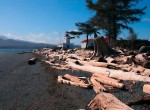 What fuels did/does a lighthouse (pharos – the Greek word for lighthouse) use? I became curious about this when I discovered in an Internet article the name Colza oil. What the heck is Colza oil? Somebody’s mispelling of Coal oil? I had to find out.
What fuels did/does a lighthouse (pharos – the Greek word for lighthouse) use? I became curious about this when I discovered in an Internet article the name Colza oil. What the heck is Colza oil? Somebody’s mispelling of Coal oil? I had to find out.
Well that led to this article on lighthouse illumination (more). I enjoyed researching it – I hope you enjoy reading it. Any additions or corrections are welcome. Please contact me.
The principal methods and types of illuminating a lighthouse are below in order of usage. The dates and equipment used are from the photo and webpage on the left. Two other excellent pages on illuminants for lamps are Illumination Sources and the lighthouse page called Pharology.
1. Open fires of wood, charcoal, tar, or coal
2. Candles of wax or tallow dips
3. Fish oil
4. Whale oil (1720-1864) – also know as Sperm oil or Train oil
5. Vegetable oils – Colza oil used in the Argand lamp; Lard Oil (1864-1884), Olive oil, Rape oil, and Coconut oil. Rice Bran oil is also used in some lands for illumination. today
(vegetable oil vs mineral oil)
6. Mineral oil – non-vegetable oils (hydrocarbon, petroleum or paraffin oils) including white oil, liquid paraffin, and liquid petroleum used as lighting oils.
7. Manufactured fuel gas, Manufactured gas or more commonly known as just Gas – gases with such names as Coal gas, City gas, Oil gas, Illumination gas (1904-1980) derived mostly from coal, but also wood, and oil. Acetylene was another manufactured gas.
8. Kerosene (1884-1955) used as a lighting oil in the vapourized oil burners
9. Electricity (1898-now) carbon-arc lamps up to present day light-emitting diode (LED) lamps
10. Solar Continue reading Fuels for Pharos
